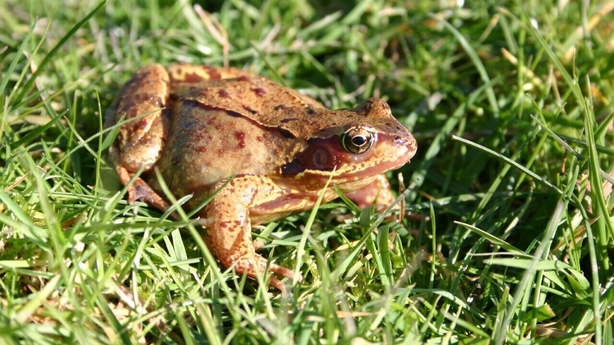Frog:
Rana temporaria (Latin name)
Froga (Irish name)

Photo - Terry Flanagan
Our common frog is known by the Latin name of Rana temporaria or temporary frog due to the fact it was only seen at certain times of the year. We now know of course that frogs hibernate for the winter. This is because they are cold-blooded animals and cannot control their body temperature from within. For this reason they hibernate or sleep for the winter.
Frogs are hard to spot as they are well camouflaged. Individuals vary in colour from green to yellow to brown, blending in with their surroundings. They have very long legs with webbed toes which are well suited both for jumping on land and swimming in water. Female frogs are much larger than male frogs.
Although called the common frog, sadly they are not as common as they once were. This is due to a number of reasons, including, pollution, loss of habitat and the vast numbers that were killed for school biology classes. Thankfully, frog dissections are now no longer undertaken in schools. More recently, a disease known as "red leg" has accounted for large numbers of frogs and gardeners have been distressed to find large quantities of bloodied dead bodies.
Frogs are amphibians, that is they can breath both on land and under water. When under water, frogs can breath directly through their skin. Frogs can also absorb water directly through the skin, so they don't need to drink.
Frogs and their behaviour have often been taken to indicate weather patterns; a bright healthy skin suggesting fine weather and dullness foretelling rain. If spawn was laid at the edges of ponds it was considered an indication of storms, while spawn laid in deep water suggested drought.
Frogs mate in January or February. Fertilisation is external, with the male frog mounting the female and releasing his sperm onto her eggs as they leave her body and enter the water. To help the male cling on to the female, his thumbs swell up into what is termed the nuptial pad. The eggs or frog spawn are surrounded by jelly, which absorbs water, swells up, and floats to the surface of the pond. Tadpoles develop from the eggs. These feed on water plants initially, but later change to feed on insects. Later on, back legs appear, followed by front legs and suddenly the tail disappears to give a tiny froglet. Always remember, it is illegal to remove frog spawn from its pond. It must be left where it is.
The expression "raining cats and dogs" originally was "raining frogs" but Cockney rhyming slang then substituted "cats and dogs" for "frogs". The mass exodus of baby frogs from their breeding ponds has long been observed and, because the movement of many thousands of baby frogs usually takes place in wet weather, it has given rise to the belief that frogs came from the sky.
The expression "having a frog in your throat" describes a type of cough, similar to the croaking of a frog. However, in olden times, eating a live frog was widely recommended as a treatment for whooping cough.
Frogs are known as the gardeners friend as they feed on many pests such as slugs and are eaten by a number of predators including herons, foxes, crows, badgers, gulls and hedgehogs.
If you want to learn more about frogs, you can visit the Irish Peatland Conservation Council and click on the 'Hop to it' Survey page where you can also take part in mapping frogs or frog spawn in your area.
QUESTIONS:
1. Why is our frog known as the temporary frog?
2. Which frog is biggest, the male or the female?
3. Give one reason why frogs are not so common nowadays.
4. Why do frogs not need to drink water?
5. At what time of the year do frogs mate?
6. What is frogspawn?
7. Whaty does 'having a frog in your throat’ mean?
8. What do frogs feed on?
9. What feeds on frogs?
10. Where can you learn more about frogs?
